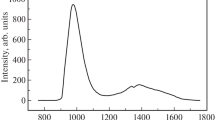Abstract
The specific features of the emission spectra of pure chemical-vapor deposited (CVD) ZnSe condensates grown with an excess of selenium and with doping with oxygen are studied. The anomalous 477(490)-nm edge emission prevailing in the low-temperature cathodoluminescence spectra of ZnSe(O) is studied in order to elucidate the nature of this emission. The relation of this emission to the stoichiometry composition of ZnSe and to the concentration of dissolved oxygen is established. The data suggesting the role of the copper impurity are obtained. On the basis of the band-anticrossing theory, a band model is developed to interpret the nature of the basic luminescence bands of ZnSe(O) and ZnSe(O,Cu) in the near-edge spectral region. It is shown that the model for ZnSe(O) is similar to the model previously proposed for ZnS(O) and CdS(O).



Similar content being viewed by others
Notes
The LW shift of the exciton band in the PCL spectra recorded for the bulk (~100 μm) at [OSe] ≈ 0.5 mol % is exemplified in Fig. 1 (curve 4). The constancy of the spectral position of the 444-nm exciton line at 80 K and the 461-nm exciton line at 300 K irrespective of [OSe] represents the content of oxygen in the informative surface layer depleted of oxygen, as discussed in detail in [16].
The 508-nm line can be seen in Fig. 3a, but its phonon component at 520 nm is not shown.
REFERENCES
M. E. Agel’manov, A. D. Levit, and E. I. Panasyuk, Neorg. Mater. 22, 387 (1991).
R. Triboulet, J. O. Ndap, A. Tromson-Carli, P. Lemasson, C. Morhain, and G. Neu, J. Cryst. Growth 159, 156 (1996).
G. D. Watkins, Bull. Am. Phys. Soc. 15, 290 (1970).
D. D. Nedooglo and A. V. Simashkevich, Electrical and Luminescent Properties of ZnSe (Shtiintsa, Kishinev, 1984) [in Russian].
N. K. Morozova, D. A. Mideros, and N. D. Danilevich, Oxygen in the Optics of II–VI Compounds in the Light of the Theory of Anti-Intersecting Zones (Saarbrücken, Germany, LAP, 2013) [in Russian].
N. K. Morozova, I. A. Karetnikov, V. V. Blinov, and E. M. Gavrishchuk, Semiconductors 35, 24 (2001).
G. B. Stringfellow and R. H. Bube, Phys. Rev. 171, 903 (1968).
N. K. Morozova, D. A. Mideros, E. M. Gavrishchuk, and V. G. Galstyan, Semiconductors 42, 131 (2008).
V. V. Blinov, Extended Abstract of Cand. Sci. Dissertation (Mosc. Power Eng. Inst., Moscow, 2003).
http://earchive.tpu.ru/handle/11683/56199.
N. K. Morozova, E. M. Gavrishchuk, I. A. Karetnikov, V. V. Blinov, V. G. Galstyan, V. S. Zimogorskii, and E. V. Yashina, Inorg. Mater. 38, 552 (2002).
G. G. Devyatykh, E. M. Gavrishchuk, and A. I. Dadanov, Vysokochist. Veshch., No. 2, 174 (1990).
V. I. Oleshko, Extended Abstract of Doctoral Dissertation (Tomsk. Polytech. Univ., Tomsk, 2009).
N. K. Morozova, N. D. Danilevich, V. I. Oleshko, and S. S. Vil’chinskaya, Izv. Vyssh. Uchebn. Zaved., Elektron. 95 (3), 3 (2012).
N. K. Morozova, I. N. Miroshnikova, and V. G. Galstyan, Semiconductors 53, 784 (2019).
N. K. Morozova, N. D. Danilevich, V. I. Oleshko, and S. S. Vil’chinskaya, Izv. Vyssh. Uchebn. Zaved., Elektron. 93 (1), 14 (2012).
N. K. Morozova and B. N. Miroshnikov, Semiconductors 52, 278 (2018).
Author information
Authors and Affiliations
Corresponding author
Ethics declarations
The authors declare that they have no conflict of interest.
Additional information
Translated by E. Smorgonskaya
Rights and permissions
About this article
Cite this article
Morozova, N.K., Miroshnikova, I.N. Anomalous Edge Emission from Zinc Selenide Heavily Doped with Oxygen. Semiconductors 54, 102–107 (2020). https://doi.org/10.1134/S1063782620010169
Received:
Revised:
Accepted:
Published:
Issue Date:
DOI: https://doi.org/10.1134/S1063782620010169




